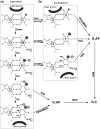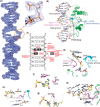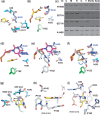Excision of 5-hydroxymethyluracil and 5-carboxylcytosine by the thymine DNA glycosylase domain: its structural basis and implications for active DNA demethylation
- PMID: 22962365
- PMCID: PMC3488261
- DOI: 10.1093/nar/gks845
Excision of 5-hydroxymethyluracil and 5-carboxylcytosine by the thymine DNA glycosylase domain: its structural basis and implications for active DNA demethylation
Abstract
The mammalian thymine DNA glycosylase (TDG) is implicated in active DNA demethylation via the base excision repair pathway. TDG excises the mismatched base from G:X mismatches, where X is uracil, thymine or 5-hydroxymethyluracil (5hmU). These are, respectively, the deamination products of cytosine, 5-methylcytosine (5mC) and 5-hydroxymethylcytosine (5hmC). In addition, TDG excises the Tet protein products 5-formylcytosine (5fC) and 5-carboxylcytosine (5caC) but not 5hmC and 5mC, when paired with a guanine. Here we present a post-reactive complex structure of the human TDG domain with a 28-base pair DNA containing a G:5hmU mismatch. TDG flips the target nucleotide from the double-stranded DNA, cleaves the N-glycosidic bond and leaves the C1' hydrolyzed abasic sugar in the flipped state. The cleaved 5hmU base remains in a binding pocket of the enzyme. TDG allows hydrogen-bonding interactions to both T/U-based (5hmU) and C-based (5caC) modifications, thus enabling its activity on a wider range of substrates. We further show that the TDG catalytic domain has higher activity for 5caC at a lower pH (5.5) as compared to the activities at higher pH (7.5 and 8.0) and that the structurally related Escherichia coli mismatch uracil glycosylase can excise 5caC as well. We discuss several possible mechanisms, including the amino-imino tautomerization of the substrate base that may explain how TDG discriminates against 5hmC and 5mC.
Figures







Similar articles
-
Excision of thymine and 5-hydroxymethyluracil by the MBD4 DNA glycosylase domain: structural basis and implications for active DNA demethylation.Nucleic Acids Res. 2012 Sep 1;40(17):8276-84. doi: 10.1093/nar/gks628. Epub 2012 Jun 27. Nucleic Acids Res. 2012. PMID: 22740654 Free PMC article.
-
Biochemical and structural characterization of the glycosylase domain of MBD4 bound to thymine and 5-hydroxymethyuracil-containing DNA.Nucleic Acids Res. 2012 Oct;40(19):9917-26. doi: 10.1093/nar/gks714. Epub 2012 Jul 30. Nucleic Acids Res. 2012. PMID: 22848106 Free PMC article.
-
Structural and mutation studies of two DNA demethylation related glycosylases: MBD4 and TDG.Biophysics (Nagoya-shi). 2014 Oct 18;10:63-8. doi: 10.2142/biophysics.10.63. eCollection 2014. Biophysics (Nagoya-shi). 2014. PMID: 27493500 Free PMC article. Review.
-
Thymine DNA glycosylase exhibits negligible affinity for nucleobases that it removes from DNA.Nucleic Acids Res. 2015 Oct 30;43(19):9541-52. doi: 10.1093/nar/gkv890. Epub 2015 Sep 10. Nucleic Acids Res. 2015. PMID: 26358812 Free PMC article.
-
Epigenetic modifications in DNA could mimic oxidative DNA damage: A double-edged sword.DNA Repair (Amst). 2015 Aug;32:52-57. doi: 10.1016/j.dnarep.2015.04.013. Epub 2015 May 1. DNA Repair (Amst). 2015. PMID: 25956859 Review.
Cited by
-
Hydroxymethylation profile of cell-free DNA is a biomarker for early colorectal cancer.Sci Rep. 2022 Oct 4;12(1):16566. doi: 10.1038/s41598-022-20975-1. Sci Rep. 2022. PMID: 36195648 Free PMC article.
-
TET-mediated oxidation of methylcytosine causes TDG or NEIL glycosylase dependent gene reactivation.Nucleic Acids Res. 2014 Jul;42(13):8592-604. doi: 10.1093/nar/gku552. Epub 2014 Jun 19. Nucleic Acids Res. 2014. PMID: 24948610 Free PMC article.
-
Catalytic mechanism of the mismatch-specific DNA glycosylase methyl-CpG-binding domain 4.Biochem J. 2020 May 15;477(9):1601-1612. doi: 10.1042/BCJ20200125. Biochem J. 2020. PMID: 32297632 Free PMC article.
-
Role of DNA methylation and the DNA methyltransferases in learning and memory.Dialogues Clin Neurosci. 2014 Sep;16(3):359-71. doi: 10.31887/DCNS.2014.16.3/mmorris. Dialogues Clin Neurosci. 2014. PMID: 25364286 Free PMC article. Review.
-
Chemical biology of genomic DNA: minimizing PCR bias.Chem Commun (Camb). 2014 Oct 18;50(81):12047-9. doi: 10.1039/c4cc05107f. Chem Commun (Camb). 2014. PMID: 25178041 Free PMC article.
References
-
- Booth MJ, Branco MR, Ficz G, Oxley D, Krueger F, Reik W, Balasubramanian S. Quantitative sequencing of 5-methylcytosine and 5-hydroxymethylcytosine at single-base resolution. Science. 2012;336:934–937. - PubMed
Publication types
MeSH terms
Substances
Associated data
- Actions
Grants and funding
LinkOut - more resources
Full Text Sources
Other Literature Sources
Molecular Biology Databases

